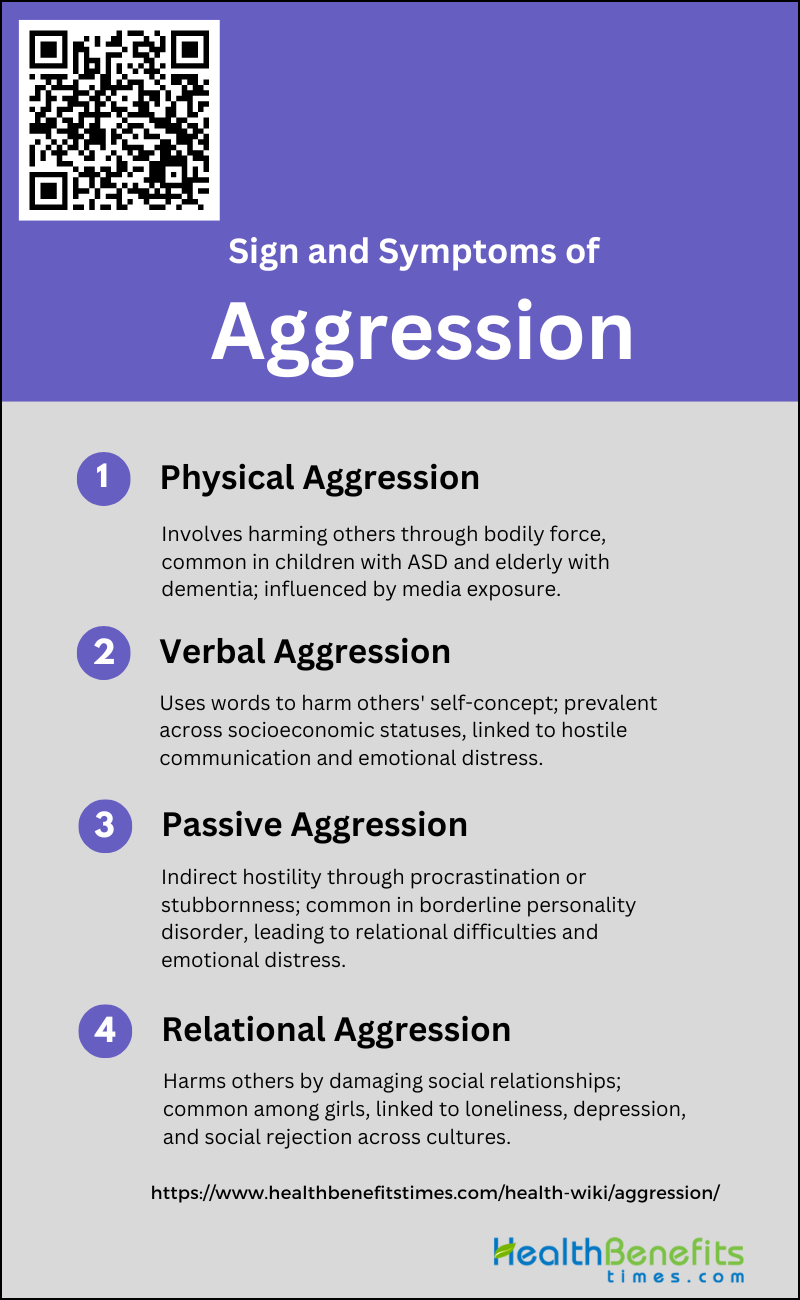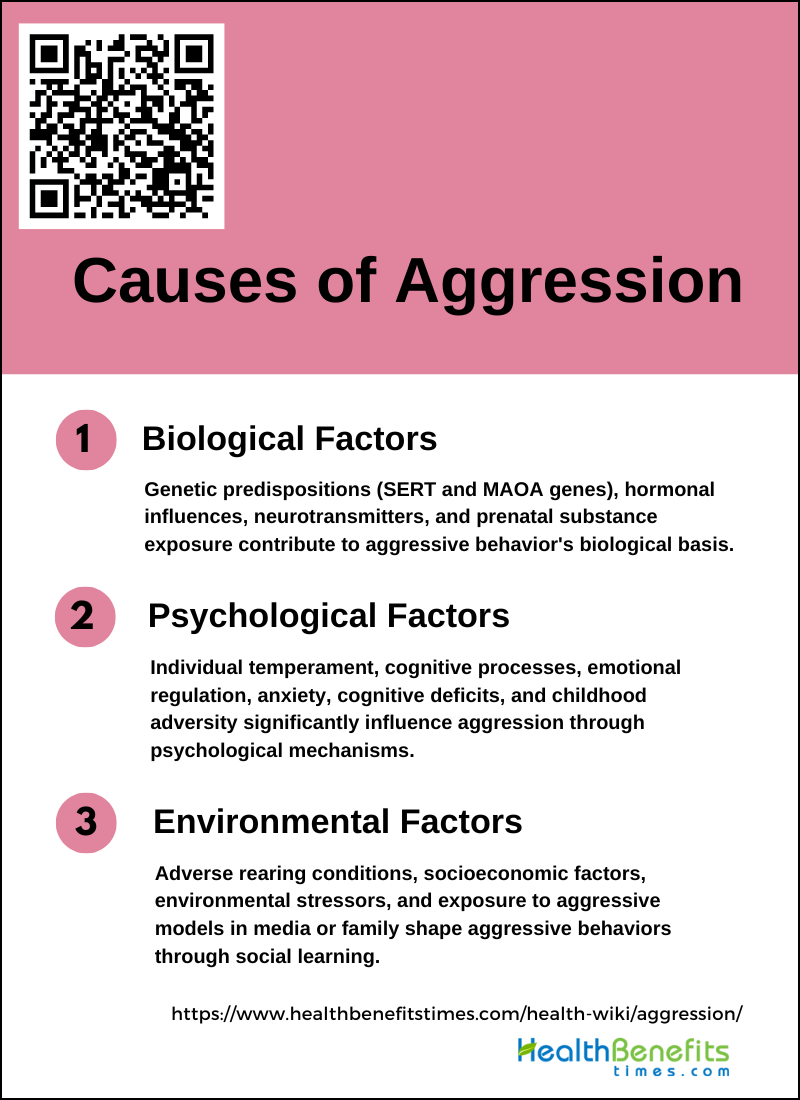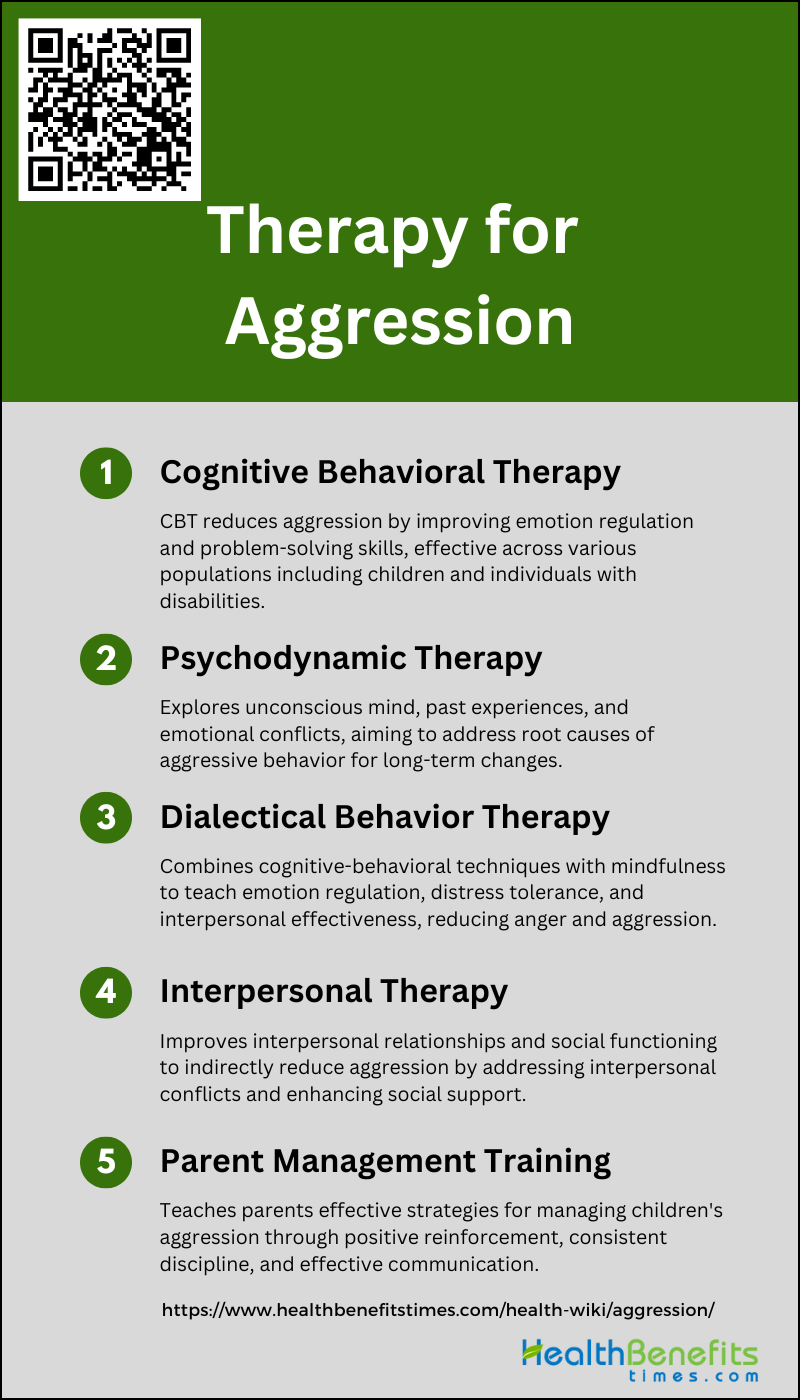Aggression is defined as behavior intended to harm another individual who does not wish to be harmed, either physically or psychologically. It encompasses a range of actions, from physical violence like hitting and kicking to verbal hostility such as insults and threats. Aggression can be impulsive, driven by emotions like anger or frustration, or instrumental, planned with a specific goal in mind. It is distinct from assertiveness, which involves standing up for oneself without intending harm. The causes of aggression are multifaceted, including biological factors like genetics and hormones, psychological factors such as mental health disorders, and environmental influences like social learning and exposure to aggressive media
Types of Aggression
Aggression also manifests in various forms, each with distinct characteristics and underlying motivations. Understanding the different types of aggression can help in identifying the root causes and developing effective strategies for management and intervention. Below is the common type of aggression encountered in both clinical settings and everyday interactions.
1. Impulsive Aggression
Impulsive aggression is characterized by spontaneous, unplanned aggressive acts often triggered by high emotional arousal. Individuals exhibiting impulsive aggression tend to have difficulty controlling their anger and may react violently in response to perceived threats or frustrations. Research indicates that impulsive aggressors often display a mixed personality profile, including traits such as Passive-Aggressive, Borderline, and Avoidant behaviors. They also report higher levels of chronic anger and fearful attachment styles, which contribute to their unpredictable and emotionally driven outbursts. This type of aggression is typically seen in intimate relationships, where the aggressor’s emotional dysregulation leads to violent episodes.
2. Instrumental Aggression
Instrumental aggression, on the other hand, is premeditated and goal-oriented. It involves the use of aggression as a means to achieve a specific objective, such as gaining control or asserting dominance. Individuals who exhibit instrumental aggression often have an Antisocial-Narcissistic-Aggressive personality profile and are more likely to engage in severe physical violence. Unlike impulsive aggressors, instrumental aggressors demonstrate suppressed physiological responses during conflicts, indicating a calculated approach to their aggressive behavior. This type of aggression is not limited to intimate relationships and can occur in various social contexts, including nonintimate interactions where the aggressor seeks to manipulate or intimidate others to achieve their goals.
Sign and Symptoms of aggression
Recognizing the signs and symptoms of aggression can be crucial for timely intervention and management. Aggression can manifest in various forms, ranging from verbal outbursts to physical confrontations. Below is a list detailing key indicators that someone may be experiencing or displaying aggressive behavior.
1. Physical Aggression
Physical aggression involves harming others through bodily force, such as hitting, kicking, or pushing. This form of aggression is prevalent among children and adolescents, particularly those with autism spectrum disorders (ASD), where it is associated with self-injury, sleep problems, and sensory issues. In elderly individuals with dementia, physical aggression is linked to cognitive decline and environmental factors, often resulting in higher psychotropic use and distress among caregivers. Studies also show that exposure to televised physical aggression can increase the likelihood of aggressive behavior in adolescents, highlighting the influence of media on physical aggression.
2. Verbal Aggression
Verbal aggression is characterized by the use of words to harm others, often by attacking their self-concept rather than their physical being. It is considered a personality trait that predisposes individuals to engage in hostile communication. Verbal aggression can be as damaging as physical aggression, leading to significant psychosocial impairment and emotional distress. Research indicates that verbal aggression is prevalent across different socioeconomic statuses and can be exacerbated by exposure to violent media. In the context of Intermittent Explosive Disorder (IED), verbal aggression is recognized as a significant symptom, often co-occurring with physical aggression.
3. Passive Aggression
Passive aggression involves indirect expressions of hostility, such as procrastination, stubbornness, or deliberate inefficiency. This form of aggression is often seen in individuals with borderline personality disorder (BPD), where it manifests as relational avoidance and irritability. Passive aggression can be challenging to identify and address because it is not overtly confrontational. It often leads to significant relational difficulties and emotional distress for both the aggressor and the recipient. Understanding the underlying attachment issues and relational anxieties can help in managing passive-aggressive behaviors in clinical settings.
4. Relational Aggression
Relational aggression aims to harm others by damaging their social relationships. This form of aggression is more common among girls and involves behaviors such as social exclusion, spreading rumors, and manipulating friendships. Relational aggression is linked to significant social-psychological adjustment issues, including loneliness, depression, and social rejection. It is also prevalent across different cultures, indicating its widespread impact on children’s social dynamics. The inclusion of relational aggression in diagnostic criteria for behavioral disorders is debated, but it is recognized as a distinct and harmful form of aggression.
Causes of Aggression
Understanding the root causes is essential for addressing and mitigating aggressive behaviors effectively. Below is a list of key factors that contribute to the emergence of aggression in individuals.
1. Biological factors
Biological factors play a significant role in the development of aggressive behavior. Genetic predispositions, such as variations in the serotonin transporter gene (SERT) and monoamine oxidase A (MAOA) gene, have been linked to increased aggression, particularly when combined with environmental stressors. Hormonal influences, including testosterone levels, and neurobiological mechanisms involving neurotransmitters like serotonin and dopamine, also contribute to aggressive tendencies. Additionally, prenatal exposure to substances like tobacco, alcohol, and cocaine can predispose individuals to aggressive behavior later in life. These biological factors interact with each other and with environmental influences, creating a complex web of determinants for aggression.
2. Psychological factors
Psychological factors influencing aggression include individual differences in temperament, cognitive processes, and emotional regulation. For instance, individuals with high levels of anxiety may perceive the world as more threatening, leading to aggressive responses as a form of self-defense. Cognitive deficits and social-cognitive problems, such as difficulties in interpreting social cues, can also predispose individuals to aggressive behavior. Furthermore, psychological stress and frustration, often stemming from adverse childhood experiences or victimization, can exacerbate aggressive tendencies. The interplay between these psychological factors and biological predispositions underscores the multifaceted nature of aggression.
3. Environmental factors
Environmental factors significantly impact the development and expression of aggressive behavior. Adverse rearing conditions, such as child abuse, neglect, and exposure to violence, are strongly correlated with increased aggression. Socioeconomic factors, including poverty and crime, also contribute to a higher risk of aggressive behavior. Additionally, environmental stressors like crowding, climate, and even lunar influences have been linked to aggression. The presence of aggressive models in the environment, such as in media or within the family, can reinforce and perpetuate aggressive behavior through social learning mechanisms. These environmental influences interact with biological and psychological factors, highlighting the importance of a holistic approach to understanding aggression.
Managing and Treating Aggression
Below are a methods and techniques aimed at managing and treating aggression.
1. Controlling Aggression
Controlling aggression involves various psychological and behavioral strategies aimed at reducing aggressive behavior. Research has demonstrated that cognitive self-regulation can play a significant role in managing aggression. For instance, a study found that individuals trained to associate hostile prime words with helpful target words exhibited lower levels of aggression in subsequent tasks, suggesting that cognitive manipulation can effectively reduce aggressive behavior. Additionally, self-control has been identified as a crucial factor in aggression management. Failures in self-control often predict aggressive behavior, while enhancing self-control can decrease aggression. This relationship is mediated by neural mechanisms involved in emotion regulation and cognitive control. Furthermore, self-control training over a period of time has been shown to reduce aggression in response to provocation, particularly among individuals with high trait aggression. These findings underscore the importance of cognitive and self-regulation processes in controlling aggressive behavior.
2. Helping Others
Helping others can be influenced by various cognitive and emotional factors. According to Weiner’s theory of responsibility, the perception of controllability plays a crucial role in determining whether individuals engage in prosocial or antisocial behavior. When people perceive a situation as controllable, they are more likely to feel anger and less likely to feel sympathy, which can inhibit help-giving and promote aggression. Conversely, uncontrollable situations elicit sympathy, promoting prosocial behavior and reducing aggression. Moreover, individuals high in agreeableness are more likely to recruit helpful thoughts in hostile contexts, which can serve to control aggressive behavior and promote helping behaviors. These cognitive and emotional processes highlight the complex interplay between thoughts, feelings, and actions in determining whether individuals choose to help others or act aggressively. Understanding these dynamics can inform interventions aimed at fostering prosocial behavior and reducing aggression.
Therapy for Aggression
Therapy offers a structured approach to understanding the root causes of aggressive behavior and developing strategies to cope with and reduce it. Below is a list of therapeutic approaches that are commonly used to address aggression.
1. Cognitive Behavioral Therapy (CBT)
Cognitive Behavioral Therapy (CBT) is a widely recognized and effective treatment for managing aggression in various populations, including children, adolescents, and individuals with intellectual disabilities. Studies have shown that CBT can significantly reduce aggressive behaviors by targeting deficits in emotion regulation and social problem-solving skills. For instance, a randomized controlled trial demonstrated that CBT could reduce violence and improve risk management in individuals with schizophrenia and a history of violence. Additionally, a meta-analysis found that CBT interventions, including skills training and problem-solving, were effective in reducing anger and improving social skills in children and adolescents. The therapy’s focus on modifying maladaptive behaviors and thought patterns makes it a versatile and effective approach for managing aggression.
2. Psychodynamic Therapy
Psychodynamic therapy, although less commonly studied in the context of aggression compared to CBT, offers a unique approach by exploring the underlying psychological forces contributing to aggressive behavior. This form of therapy delves into the unconscious mind, past experiences, and emotional conflicts that may manifest as aggression. While specific studies on psychodynamic therapy for aggression are limited, the therapy’s emphasis on understanding the root causes of behavior can provide valuable insights and long-term benefits. By addressing these deep-seated issues, psychodynamic therapy aims to bring about profound changes in behavior and emotional regulation, potentially reducing aggressive tendencies over time.
3. Dialectical Behavior Therapy (DBT)
Dialectical Behavior Therapy (DBT) is a promising treatment for managing anger and aggressive behavior. DBT combines cognitive-behavioral techniques with mindfulness practices to address maladaptive behaviors by teaching emotion regulation, distress tolerance, interpersonal effectiveness, and core mindfulness skills. A review of DBT for anger and aggression found that the therapy showed clinically significant results in reducing these behaviors across various populations. The therapy’s structured approach and focus on skill-building make it particularly effective for individuals with complex emotional and behavioral issues, including those with borderline personality disorder and other conditions associated with aggression.
4. Interpersonal Therapy
Interpersonal Therapy (IPT) focuses on improving interpersonal relationships and social functioning, which can indirectly reduce aggressive behaviors. Although specific studies on IPT for aggression are scarce, the therapy’s emphasis on resolving interpersonal conflicts, improving communication skills, and building social support networks can contribute to better emotional regulation and reduced aggression. By addressing the social and relational aspects of an individual’s life, IPT helps create a more supportive environment that can mitigate triggers for aggressive behavior. This approach is particularly beneficial for individuals whose aggression is closely linked to interpersonal stressors and conflicts.
5. Parent Management Training (PMT)
Parent Management Training (PMT) is an evidence-based intervention aimed at improving parenting skills to manage children’s disruptive behaviors, including aggression. PMT focuses on altering aversive patterns of family interactions that contribute to children’s aggressive behavior. Studies have shown that PMT is effective in reducing aggression by teaching parents strategies for positive reinforcement, consistent discipline, and effective communication. The training helps parents create a more structured and supportive home environment, which can significantly reduce aggressive behaviors in children. PMT has been extensively studied and validated in randomized controlled trials, making it a reliable approach for managing childhood aggression.





